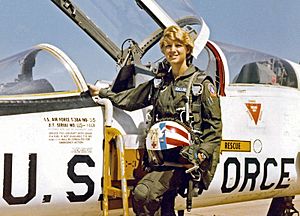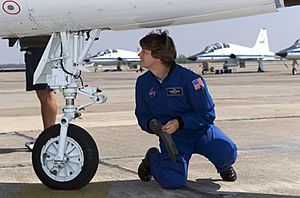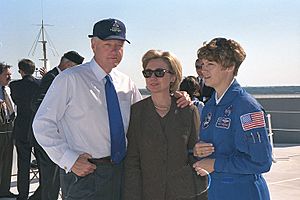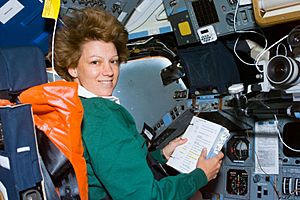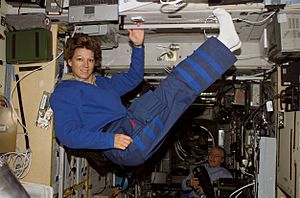Eileen Collins facts for kids
Quick facts for kids
Eileen Collins
|
|
|---|---|

Collins in 1998
|
|
| Born |
Eileen Marie Collins
19 November 1956 Elmira, New York, U.S.
|
| Awards |
|
| Space career | |
| NASA astronaut | |
| Rank | Colonel, USAF |
|
Time in space
|
36d 7h 11m |
| Selection | NASA Group 13 (1990) |
| Missions | STS-63 STS-84 STS-93 STS-114 |
|
Mission insignia
|
|
| Retirement | 1 May 2006 |
| Military career | |
| Years of service | 1978–2005 |
| Battles/wars | United States invasion of Grenada |
Eileen Marie Collins (born 19 November 1956) is an American retired NASA astronaut and Air Force colonel. She was a flight instructor and test pilot. Collins made history as the first woman to pilot the Space Shuttle. She was also the first woman to command a Space Shuttle mission.
Eileen graduated from Corning Community College in 1976 with a degree in mathematics. She then went to Syracuse University, earning a degree in mathematics and economics in 1978. She joined the Air Force through a special training program. Eileen was one of only four women chosen for pilot training at Vance Air Force Base. After becoming a pilot, she taught others to fly T-38 Talon jets for three years. Later, she flew the C-141 Starlifter transport plane. During a military operation in Grenada in 1983, her plane flew soldiers and brought medical students back home.
From 1986 to 1989, she taught mathematics at the United States Air Force Academy. She also earned two master's degrees during this time. In 1989, she became the second woman pilot to attend the USAF Test Pilot School. She graduated in 1990.
In 1990, NASA chose Collins to be a pilot astronaut. She piloted the Space Shuttle Discovery on the STS-63 mission in 1995. This mission involved meeting up with the Russian space station Mir. She also piloted the STS-84 mission in 1997. In 1999, she became the first woman to command a U.S. spacecraft on STS-93. This mission launched the Chandra X-Ray Observatory. In 2005, she commanded STS-114, a special "return to flight" mission after the Space Shuttle Columbia disaster. This mission tested new safety features and resupplied the International Space Station (ISS). During this flight, she performed a unique 360-degree flip of the Space Shuttle. This allowed astronauts on the ISS to check the shuttle for damage. She retired from the Air Force in 2005 and from NASA in 2006.
Contents
Early Life and Education
Eileen Marie Collins was born in Elmira, New York, on 19 November 1956. Her parents were James and Rose Marie Collins. Her father's family came from Ireland. Eileen had three siblings. Her father was a surveyor after serving in the US Navy during World War II.
As a child, Eileen was shy and had speech therapy. She was a Girl Scout. She dreamed of becoming a pilot from a young age. She read books about military pilots from World War II.
Eileen went to St. Patrick's School and then Notre Dame High School. After her family's home was damaged by a flood in 1972, she moved to Elmira Free Academy, a public high school. She graduated in 1974. Eileen wanted to join the US Air Force, but her father disagreed. Instead, she attended Corning Community College. She earned an associate degree in mathematics in 1976. She then chose Syracuse University because it had an Air Force Reserve Officer Training Corps (AFROTC) program.
In 1975, the United States Air Force (USAF) began allowing women to train as pilots for non-combat missions. Eileen followed the progress of the first women pilots. She hoped to follow them into the sky.
Eileen took flying lessons in a Cessna 150 plane. She even flew solo. In 1978, she was offered a chance to train as a pilot through the AFROTC program. She passed the physical exam after a re-test for her eyesight. She graduated from Syracuse University with degrees in mathematics and economics.
Air Force Pilot Career
After graduating, Eileen became a second lieutenant in the USAF. She went to Lackland Air Force Base in Texas for pilot screening. She was one of four women in her class. She passed the screening despite some medical concerns.
For her main pilot training, Eileen went to Vance Air Force Base in Oklahoma. There were three other women in her class. She decorated her helmet with "E = mc2", linking her initials to Albert Einstein's famous equation. She was the first in her class to fly solo in a Cessna T-37 Tweet.
In March 1979, she began training in the Northrop T-38 Talon jet. She earned her pilot wings and was chosen to be a flight instructor. She became the first woman T-38 instructor pilot. She was the only woman flight instructor at Vance from 1979 to 1982.
As a captain, Eileen wanted to become an astronaut. To do this, she needed to graduate from the USAF Test Pilot School. She needed over a thousand hours of flying time in an operational aircraft. Since trainers were not considered operational, she was assigned to fly the Lockheed C-141 Starlifter transport plane at Travis Air Force Base in California. She flew long missions across the Pacific and to Europe.
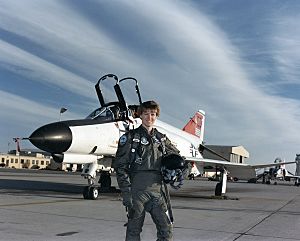
During the invasion of Grenada in October 1983, her plane flew troops to Grenada. It also brought thirty-six medical students back. Even though women were not supposed to fly in combat, she received combat pay for this mission. She was also awarded the Armed Forces Expeditionary Medal. After nine months, she became a first pilot. In June 1984, she became an aircraft commander.
From 1986 to 1989, Eileen taught mathematics at the United States Air Force Academy in Colorado. She also taught flying in a T-41 plane. She earned a master's degree in operations research from Stanford University in 1986. She also earned a master's degree in space systems management from Webster University in 1989. She married James P. (Pat) Youngs, a fellow C-141 pilot, in 1987.
Earning advanced degrees helped her chances for the USAF Test Pilot School. Her first two applications were rejected because she needed to serve longer at the Air Force Academy. In 1989, her third application was accepted. Captain Jacquelyn Susan "Jackie" Parker was the first woman to graduate from the school in 1988.
Eileen became the second woman pilot to attend the school in June 1989. She was the most senior member of her class. At Edwards, she flew many different types of aircraft. She graduated in June 1990.
Astronaut Career Highlights
Becoming an Astronaut
In April 1989, NASA announced it was selecting new astronauts. Eileen applied. In September 1989, she was invited to the Johnson Space Center (JSC) for interviews and medical tests. Her eyesight was a concern again, but she passed an alternative test. On 16 January 1990, she received a call from astronaut John Young. He told her she was selected as a pilot astronaut. He said, "You will be the first woman to pilot the Space Shuttle!"
Eileen was one of twenty-three new astronauts in NASA Astronaut Group 13. They called themselves the "Hairballs." She started at JSC on 16 July 1990. She already knew Susan Helms, another member of her group. Pilot astronauts practiced flying the T-38 jet. They also learned about the Space Shuttle and its systems. They trained for survival on land and water. After nine months, Eileen was assigned to work on the Space Shuttle's systems.
Later, Eileen worked at the Kennedy Space Center (KSC) in Florida. She helped check the Space Shuttle's systems before launch. She also helped astronauts get into their seats before takeoff and out after landing. She spent sixteen months helping with ten Space Shuttle missions. After this, she became a capsule communicator (CAPCOM) at JSC.
STS-63: First Woman Pilot
Eileen Collins first flew the Space Shuttle as a pilot in 1995 on STS-63. This was a historic moment, as she was the first woman to pilot the Space Shuttle. Two other women pilots, Pamela Melroy and Susan Kilrain, later followed in her footsteps.
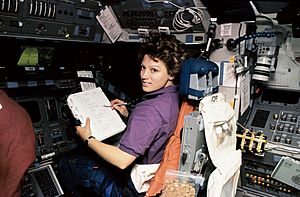
The STS-63 mission involved a close approach between the Space Shuttle Discovery and the Russian space station Mir. It was the first time a Space Shuttle flew so close to Mir, though it did not dock. A Russian cosmonaut, Vladimir Georgiyevich Titov, was part of the crew.
To prepare, Eileen practiced over 500 approaches and landings in a special training aircraft. The crew also visited Russia to learn about Mir. Seven of the surviving members of the Mercury 13, a group of women who trained to be astronauts in the 1960s, attended the launch on 3 February 1995.
During the mission, there were some issues with the shuttle's thrusters. But eventually, Discovery was able to approach Mir safely. Besides the rendezvous, Discovery carried a Spacehab module and an astronomy satellite. Eileen felt a bit sick at first, but she recovered. Her duties included managing a Coca-Cola dispensing machine for experiments. Discovery landed back at KSC on 11 February 1995. The flight lasted over 8 days.
Soon after this mission, Eileen became pregnant. Her first child, Bridget, was born nine months later.
STS-84: Docking with Mir
In August 1995, Eileen was assigned to her second mission, STS-84. This mission would actually dock with Mir. Astronaut Michael Foale would stay on Mir for four months, and astronaut Jerry Linenger would return to Earth. A Russian cosmonaut, Yelena Kondakova, was also on the crew. The mission commander, Charles Precourt, spoke Russian well.
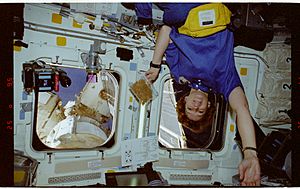
The STS-84 mission used the Space Shuttle Atlantis. Eileen completed one hundred hours of Russian language training. The crew traveled to Star City in Russia to learn about Mir's systems.
Atlantis launched from KSC on 15 May 1997, without any delays. It docked with Mir the next day. This time, Eileen felt no nausea. Crew members were exchanged, and over 7,300 pounds of equipment and supplies were transferred to Mir.
Eileen spent much of her time filling bags with drinking water. She also took many photos of Mir from outside. The Russian commander offered some cognac, which was allowed on Mir but not on the Space Shuttle. Eileen also photographed Comet Hale–Bopp, a very bright comet. Atlantis returned to KSC on 24 May, after a flight of nearly 10 days.
STS-93: First Woman Commander
Astronauts usually pilot two missions before commanding one. Eileen told NASA she was interested in commanding the mission to deploy the Chandra X-ray Observatory. In March 1998, it was announced that she would command STS-93. This was a huge step, as she became the first woman to command a Space Shuttle mission. The announcement was made by the first lady, Hillary Rodham Clinton, at the White House.
Jeffrey Ashby was the pilot for this mission. The crew also included astronauts Cady Coleman and Steven Hawley, and French astronaut Michel Tognini. Hawley was a very experienced astronaut who had helped deploy the Hubble Space Telescope. Eileen was a bit worried he might try to take over, but he offered great advice instead.
The STS-93 mission was challenging. The Space Shuttle Columbia had to be used because it was the only one that could carry the heavy Chandra X-ray Observatory. The launch was delayed several times due to technical issues.
The Chandra X-ray Observatory and its launch system were very heavy. This made it the heaviest payload ever launched by the Space Shuttle. To save weight, the crew was reduced to five members, and the mission was planned for only five days. This was one of the shortest missions since 1990. The large weight also made an emergency landing very risky.
The launch day, 20 July 1999, was the 30th anniversary of the Apollo 11 Moon landing. Former astronauts Neil Armstrong, Buzz Aldrin, and Michael Collins were there to watch. Hillary Clinton and the United States women's national soccer team were also present. The launch was halted just before the engines started due to a faulty sensor. It was rescheduled for two days later, then delayed again by bad weather.
On the third attempt, Columbia finally lifted off on 23 July. There was a problem with one of the main engines during takeoff, causing it to cut out early. The shuttle reached a lower orbit than planned, but the situation could have been much worse. After the flight, similar problems were found in other Space Shuttles, and the entire fleet was grounded until December.
Despite the challenges, the Chandra X-ray Observatory was successfully deployed. The crew then used a special imaging system to take ultraviolet pictures of Earth, the Moon, and other planets. Eileen used her amateur radio station to talk to children. On 27 July, Eileen landed Columbia at night, which was only the twelfth night landing in the Space Shuttle program. The flight lasted almost 5 days. She received the Distinguished Flying Cross for this mission.
After the flight, Eileen appeared on TV shows and opened the New York Stock Exchange. She had a son, Luke, in November 2000.
STS-114: Return to Flight
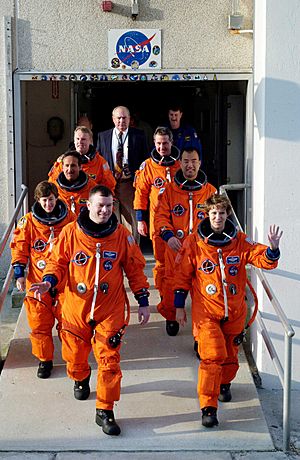
After STS-93, Eileen became the chief of the Space Shuttle Branch at the Astronaut Office. In late 2001, she was assigned to command STS-114.
The STS-114 mission involved docking Atlantis with the ISS to transfer crew and supplies. Jim Kelly was the pilot, and Stephen Robinson, Soichi Noguchi, Andy Thomas, Wendy Lawrence, and Charles Camarda were mission specialists. The mission would transfer over 1,100 cubic feet of supplies to the ISS. Three spacewalks were planned to install equipment and replace a gyroscope. Eileen was concerned about the busy schedule, knowing it could lead to mistakes.
The launch was delayed several times due to problems with the Space Shuttle's fuel lines. After the Space Shuttle Columbia disaster in February 2003, STS-114 became NASA's "return to flight" mission. Its main goal was to test new safety improvements and resupply the ISS. The crew remained the same, with additional specialists added for the increased workload.
Eileen visited the factories where Space Shuttle parts were made. She wanted to understand the safety improvements. When asked if she was afraid after the Columbia disaster, she said she wanted to fly again when the shuttle was cleared to fly.
She had concerns about the bolts holding the Space Shuttle on the launch pad and other parts. These were redesigned for STS-114. Because of problems found on Atlantis, Discovery was used for the STS-114 mission instead.
Discovery was rolled out to the launch pad in April 2005. More sensor problems caused further delays. The mission finally launched on 26 July 2005, after a perfect countdown. However, video showed that foam pieces broke off the external tank during liftoff. This was the same problem that caused the Columbia disaster. Eileen felt responsible for not pushing harder for changes.
The STS-114 mission continued. Eileen became the first astronaut to fly the Space Shuttle through a complete 360-degree pitch maneuver. This allowed astronauts on the ISS to take photos of Discovery's underside to check for damage. She then docked with the ISS. Inspections showed some issues with the shuttle's heat shield tiles. The three spacewalks and supply transfers went smoothly. On the third spacewalk, astronaut Robinson removed two protruding gap fillers from the shuttle's belly.
Discovery was supposed to land at KSC on 8 August, but bad weather forced a delay and a change to Edwards Air Force Base. Discovery landed after a mission lasting almost 14 days. Eileen was not happy with her landing, feeling it was a bit fast. Her feet hurt for two weeks as her bones adjusted back to Earth's gravity.
Later Life and Recognition
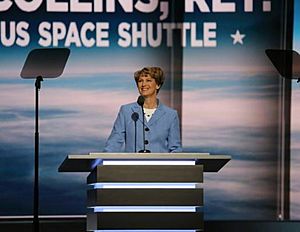
Eileen Collins retired from the U.S. Air Force in January 2005 as a colonel. On 1 May 2006, NASA announced she was leaving to spend more time with her family. She had flown 6,751 hours in thirty different types of aircraft. She spent over 872 hours in space.
After retiring, Eileen served on the Board of Directors for USAA, a banking and insurance company, until 2021. She also remained involved with NASA, chairing the Space Operations Committee of the NASA Advisory Council from 2007 to 2011.
Eileen sometimes appeared on CNN as an analyst for Space Shuttle launches and landings. She gave the commencement speech at Syracuse University in May 2001. She spoke at the 2016 Republican National Convention in Cleveland, Ohio, on 20 July 2016.
Awards and Honors
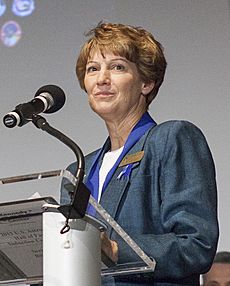
Eileen Collins has received many awards. These include the Legion of Merit, the Distinguished Flying Cross, and several NASA medals. She received the Golden Plate Award in 2001. She also received the National Space Trophy and the Adler Planetarium Women in Space Science Award in 2006. In 2007, she received the Space Foundation Douglas S. Morrow Public Outreach Award. She was awarded the Harmon Trophy in 2020 and the Wright Brothers Memorial Trophy in 2022.
Collins was inducted into the National Women's Hall Of Fame in 1995. She joined the National Aviation Hall of Fame in 2009. On 19 April 2013, she was inducted into the United States Astronaut Hall of Fame. She also entered the Texas Aviation Hall Of Fame in 2020. The Encyclopædia Britannica recognized her as one of 300 women who have changed the world.
An astronomical observatory, the Eileen Collins Observatory at Corning Community College, is named after her. The main entrance road to Syracuse Hancock International Airport is also named in her honor. Webster University awarded her an honorary Doctor of Science in 1996. In 2021, she received Syracuse University's highest alumni honor, the George Arents Award. University College Dublin in Ireland also gave her an honorary Doctor of Science degree in 2006.
See also
 In Spanish: Eileen Collins para niños
In Spanish: Eileen Collins para niños


